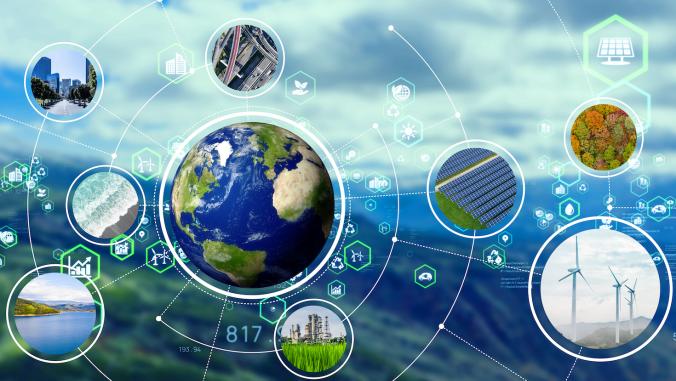Partnering with cities on climate action plans
A primer for companies on working with local governments to address issues of mutual concern.

Sixth in a series on the role of public-private collaboration in realizing smart, sustainable cities, systems and industries.
When it comes to climate action, the plot has been thickening. September’s Step Up Declaration, led by Salesforce and signed by 21 technology firms and counting, called upon business "to create a step-change in corporate commitments" to protect the 2020 deadline for bending the curve of global greenhouse gas emissions. November’s climate report — issued by U.S. federal agencies, no less — echoed the warning. And now, last week’s Talanoa Call for Action (PDF), crafted at COP24 in Poland, underscores the point.
The game is on. If climate rehab is Act One of the massively multiplayer climate action game, confronting climate with an action plan is Act Two.
"Climate Action Plan" is language most typically used in the context of cities. But every business needs one, ideally aligned with or advanced in collaboration with their city or cities of choice. If your firm, whether large or small, has not begun this work, now is the time.
How to think about climate action
A formal Climate Action Plan describes the causes and local impacts of climate change; sets a greenhouse gas emissions reduction target; outlines actions to reduce those emissions; and launches an implementation strategy. You will want to work with your sustainability director or another key leader in your firm to approach your city and your Climate Action Plan strategically.
Meanwhile, just get started.
Approaching your city
Reach out to your target city and find out what it most wants to do — and why. "Partnership" may mean simple goal alignment, doing your part to cooperate with explicit city initiatives. Or it may involve more proactive and complex collaboration. Bring your own insights, interests, capacities, resources and creativity into play.
If available, work through facilitative organizations such as the Business Council on Climate Change (BC3) in the San Francisco Bay Area. "We formed 10 years ago to bring business into conversation with the city, to more easily let them see what they can do together," said BC3 Executive Director Maura McKnight at an affiliate event of the Global Climate Action Summit (GCAS), in September in San Francisco.
“Outside of our formal partnerships, we are all in a long partnership together,” noted Garrett Fitzgerald, strategic partnerships adviser for the Urban Sustainability Directors Network, or USDN. “Key to [formal] partnership is an eagerness to work together, and to move beyond transactional partnership into long-term, action-oriented” collaboration. "Be clear on the timeframe, be clear on your contribution," Fitzgerald continued. "And be honest with yourself and others: What am I going to be good at?"
Actions for every plan
Every action that reduces dirty and non-renewable energy, food waste, resource consumption and non-electric vehicle miles traveled is ultimately a climate action. As has been demonstrated, most climate actions save money, increase resiliency, improve health and attract and retain employees and customers.
The following action ideas — informed by GCAS, BC3, USDN’s Carbon-Neutral Cities Alliance “Game Changers” report, new research from the C40 Cities network, years of GreenBiz reporting and more — can help jumpstart your company’s climate action planning.
- Energy: Be sure to sign up for your local clean energy option, if available. Or aggregate buying power via power purchase agreements (PPAs) and virtual PPAs through organizations such as BC3, or secure discounts on solar and EVs through a local SunShares program. Increasingly, firms of any size are finding or creating new procurement options for renewable energy; jump onto that bandwagon here. Once you’ve got your electricity clean, begin to electrify your heating and cooling systems, and any other systems you can.
- Food: If your business provides foodservice, take the Cool Food Pledge and offer more plant-based options. Reduce food waste to dramatic effect using local apps which can find all uneaten food a home. No such service in your city? Consider creating one. Compost any food waste you cannot prevent, especially if your city provides a service. Finally, if you’re an innovator take note: You may be able to turn food waste into input for your product innovation cycle, or dig into food’s future with Foodshot, whose global Soil 3.0 challenge application period closes soon.
- Materials: Serve up food in reusable packaging and do what you can to make takeaway packaging low-impact — it matters to your customer. As for the rest of your waste, go the extra mile to manage it in the way your city and its providers most want you to. Perhaps your city is among the 25 that have signed the Advancing Toward Zero Waste declaration, led by the C40 Cities network. Regardless whether it is, do all you can to cooperate with your city’s waste management goals.
- Vehicle miles: Install bike racks and benches in coordination with your city, as these amenities aid walkability and bring potential customers to your door. Or get strategic and become a bicycle friendly business. Offer transit cards as an employee benefit; see Seattle’s ORCA and San Francisco’s Clipper. If you’re a large employer, concentrate jobs near transit hubs, or work with mobility firms such as Scoop and Waze to facilitate workplace carpools. Use companies such as ChargePoint to help you host a charging station, while helping the company reach its 2.5 million station commitment. Is your city among the 12 signing the Fossil-Fuel-Free Streets declaration led by the C40 Cities network? If so, perhaps there’s a role you can play in helping zero-emissions-zones take shape.
Taking it further
- Green SMEs: According to SuperGreen Solutions, "Small and medium-sized enterprises (SMEs) account for 99 percent of all businesses," many of them serving cities. To that end, they launched a global partnership earlier this year "to identify and remove the barriers preventing SMEs from pursuing sustainable business practices." Earn an ISO 14001 sustainability certification with SuperGreen. Or, if you are a retail outlet, you may be inspired by Starbucks’ recently articulated Greener Stores Framework.
- Live large: Large businesses enjoy even more options to help their cities reach their climate goals. Move your building portfolios toward a net-zero profile. Build your own microgrid. Divest in fossil fuels, following the lead of NYC and other large scale investors. Invest in the low-carbon economy — there's a new playbook for that.
- Reduce your risk: Participate in local resiliency planning and partnering to reduce your risks. Resilient by Design in the Bay Area brought together communities and design experts to envision on-the-ground design adaptations in response to climate change; as designs such as these evolve and on-the-ground initiatives emerge, your firm may find a way to partner for success.
Next up
If climate rehab is the set-up of the climate action game, and confronting climate with an action plan follows, settling into the business of delivering a sustaining product or service is Act Three. More on that next year.





